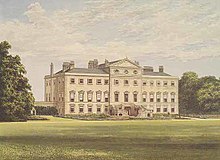
Lathom House was a large country house in the parish of Lathom in Lancashire, England. Built between 1725 and 1740, the main block was demolished in 1925.

Lathom House was a large country house in the parish of Lathom in Lancashire, England. Built between 1725 and 1740, the main block was demolished in 1925.


A wooden castle is believed to have stood on the site in mediaeval times. Sir John I Stanley of the Isle of Man (1350–1414), Lord Lieutenant of Ireland and King of Mann married Isabel Latham, daughter and heiress of Sir Thomas Latham of Latham. [1] The stone-built castle known as Lathom House, built by the Stanley family in 1496, had eighteen towers, and was surrounded by a wall six foot thick and a moat eight yards wide, its drawbridge defended by a gateway tower. In the centre of the site was a tall tower known as the Eagle Tower. [2]
In 1554, Protestant martyr George Marsh, was questioned at Lathom House by Edward Stanley, 3rd Earl of Derby before being sent to Lancaster Castle. [3]
Lathom House was the last Royalist stronghold in Lancashire during the English Civil War and was twice besieged by Parliamentarian forces. During the first Siege of Lathom House by Sir Thomas Fairfax in 1644, the house was defended by Charlotte Stanley, Countess of Derby and 300 men who kept possession until Royalist forces under Prince Rupert of the Rhine arrived in the area en route to attack Bolton. After the siege, at Rupert's insistence, the countess and her retinue moved to the Isle of Man, with the defence of the house being entrusted to professional soldiers. In 1645 the house was again besieged by General Egerton with 4000 Parliamentarian soldiers, and was surrendered after a protracted siege after which the fortifications were demolished by the Parliamentarians. [4] James Stanley, 7th Earl of Derby, husband of Charlotte, was beheaded in Bolton by the Parliamentarians in 1651 for treason. The Stanley manors were confiscated by Parliament. [5]
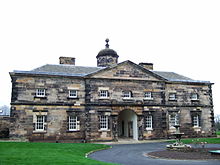
After the Restoration of the monarchy in 1660, Lathom House was returned to the Stanleys and remained with them until 1714 when it passed by the marriage of Henrietta Stanley to John Ashburnham, 3rd Baron Ashburnham who sold it. [5]
It was subsequently bought by Sir Thomas Bootle, MP for Liverpool, [5] who commissioned Giacomo Leoni to rebuild the house as the finest Palladian house in the county. Built over 15 years from 1725–40, its deer park was designed by renowned landscape gardener Humphry Repton. [6]
It passed through his niece to Richard Wilbraham Bootle and their son, Edward, Lord Skelmersdale. [5] The latter's grandson Edward inherited and was made Earl of Lathom. Edward's son, the second earl, was accidentally shot and died in 1910. The last resident of Lathom House was Edward Bootle-Wilbraham 3rd Earl of Lathom (and 4th Baron of Skelmersdale). During the First World War the hall was used for military purposes, mainly the training of horses, and after the war the third earl decided not to renovate and reoccupy it but to live instead at nearby Blythe Hall. [7]
The estate was sold in 1920 to a London consortium. After a brief period as a boys’ school, the main block of the house was demolished in 1925. [8] The estate land of 4000 acres was sold piecemeal, mainly to the tenants. The remaining west wing of the house was converted to apartments. [9]
The ruins of Lathom House were excavated by the Historical Council of Northern Lancashire, in its efforts to reconstruct the 18th-century buildings; the team on site came across medieval foundations and have tried to salvage them. While the main buildings became uninhabitable several decades ago, there are almshouse cottages neighbouring the Lathom Park Chapel. [10]

Earl of Derby is a title in the Peerage of England. The title was first adopted by Robert de Ferrers, 1st Earl of Derby, under a creation of 1139. It continued with the Ferrers family until the 6th Earl forfeited his property toward the end of the reign of Henry III and died in 1279. Most of the Ferrers property and the Derby title were then held by the family of Henry III. The title merged in the Crown upon Henry IV's accession to the throne in 1399.
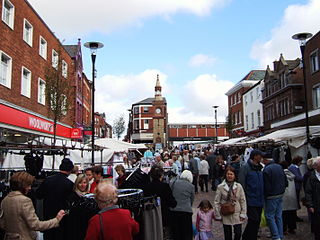
Ormskirk is a market town in the West Lancashire district of Lancashire, England, 13 miles (21 km) north of Liverpool, 11 miles (18 km) northwest of St Helens, 9 miles (14 km) southeast of Southport and 18 miles (29 km) southwest of Preston. Ormskirk is known for its gingerbread.
Baron Skelmersdale, of Skelmersdale in the County Palatine of Lancaster, is a title in the Peerage of the United Kingdom. It was created in 1828 for the former Member of Parliament for Westbury, Newcastle-under-Lyme, Clitheroe and Dover, Edward Bootle-Wilbraham. His grandson, the second Baron, was a Conservative politician and served in the Conservative administrations of Disraeli and Lord Salisbury. In 1880 he was created Earl of Lathom, in the County Palatine of Lancaster, in the Peerage of the United Kingdom. However, the earldom became extinct on the death of his grandson, the third Earl, in 1930. The barony passed to the last Earl's second cousin once removed, the fifth Baron, who was the grandson of a younger son of the first Baron. On his death, the title was inherited by his cousin, the sixth Baron.

James Stanley, 7th Earl of Derby, KG was an English nobleman, politician, and supporter of the Royalist cause in the English Civil War. Before inheriting the title in 1642 he was known as Lord Strange. He was feudal Lord of the Isle of Man, where he was known as "Yn Stanlagh Mooar".
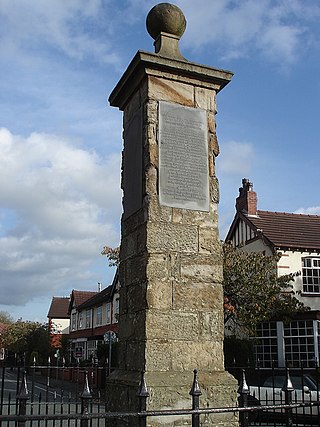
The Battle of Wigan Lane was fought on 25 August 1651 during the Third English Civil War, between a Royalist army led by the Earl of Derby and forces loyal to the Commonwealth of England under Colonel Robert Lilburne. The Royalists were defeated, losing nearly half their officers and men.

Lathom is a village and civil parish in Lancashire, England, about 3 miles (5 km) northeast of Ormskirk. It is in the district of West Lancashire, and with the parish of Newburgh forms part of Newburgh ward. The population of the civil parish at the 2011 census was 914. The Leeds and Liverpool Canal passes through Lathom.

Edward Bootle-Wilbraham, 1st Earl of Lathom, known as The Lord Skelmersdale between 1853 and 1880, was a British Conservative politician. He was a member of every Conservative administration between 1866 and 1898, and notably served three times as Lord Chamberlain of the Household under Lord Salisbury. Having succeeded his grandfather as Baron Skelmersdale in 1853, he was created Earl of Lathom in 1880.

Charlotte Stanley, Countess of Derby, born Charlotte de La Trémoille, is famous for her robust defence of Lathom House during the English Civil War.

Knowsley Hall is a stately home near Liverpool in the Metropolitan Borough of Knowsley, Merseyside, England. It is the ancestral home of the Stanley family, the Earls of Derby. The hall is surrounded by 2,500 acres (10 km2) of parkland, which contains the Knowsley Safari Park. Though the hall is still owned by the Stanley family, it is no longer a family home, but is instead used for corporate events, conferences and weddings. Since 1953 it has been designated a Grade II* listed building,
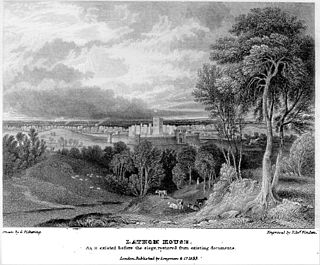
The siege of Lathom House was a military confrontation between a Parliamentarian army and a Royalist stronghold in Lathom near Ormskirk in Lancashire, during the First English Civil War. The first siege lasted from late February to late May 1644, when the siege was lifted. The second siege took place a year later from July to December 1645. Lathom House was captured and slighted.
Edward Bootle-Wilbraham, 1st Baron Skelmersdale, was a British landowner and politician.
The Storming of Bolton, sometimes referred to as the "Bolton massacre", was an event in the First English Civil War which happened on 28 May 1644. The strongly Parliamentarian town was stormed and captured by Royalist forces under Prince Rupert. It was alleged that up to 1,600 of Bolton's defenders and inhabitants were slaughtered during and after the fighting. The "massacre at Bolton" became a staple of Parliamentarian propaganda.
Edward George Bootle-Wilbraham, 2nd Earl of Lathom JP KStJ, was an English Army officer and peer.

Greenhalgh Castle is a castle, now ruined, near the town of Garstang in Lancashire, England.
Richard Bootle-Wilbraham was a British Conservative Party politician. He sat in the House of Commons from 1835 to 1844.

Blythe Hall is a large grade II listed country house in Lathom, Lancashire, England, some 3 miles (5 km) north-east of Ormskirk.

Westhead is a village in the West Lancashire district of Lancashire, England. As of 2014, the estimated population was 886.
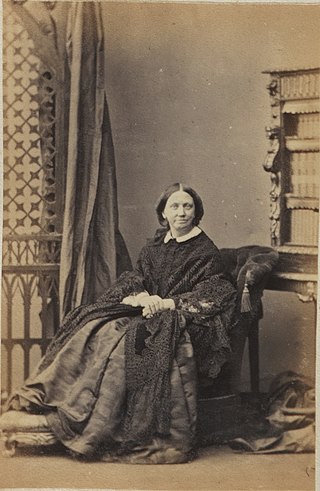
Emma Caroline Smith-Stanley was the Countess of Derby as the wife of Edward Smith-Stanley, 14th Earl of Derby, who served as Prime Minister of the United Kingdom three times in the mid-19th century.
Richard Wilbraham-Bootle was a British landowner and politician who sat in the House of Commons for 29 years from 1761 to 1790.
Robert Bootle FRS was an English ship's captain in the service of the East India Company who was elected four times to serve as a director of the company.